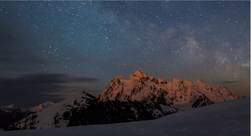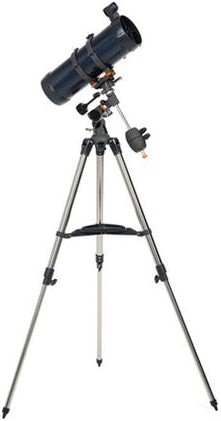How Filters Can Better Your View
May 4, 2015
You just got your new telescope - you carefully opened the box and followed all the instructions. That sun just will not go down fast enough. Finally, darkness falls. The first thing a new telescope owner will do is point it up at the Moon and look into the eyepiece. Wow.
But if you can imagine, the Moon actually can appear better than that when properly filtered. Telescopes have the ability to attach filters for many different purposes - some of the most common filters are for looking at the Moon, Planets and Sun.
Eyepiece filters are an invaluable aid in lunar and planetary observing. They reduce glare and light scattering, increase contrast through selective filtration, increase definition and resolution, reduce irradiation and lessen eye fatigue.


Moon Filters
A Moon Filter will thread directly onto the bottom of your eyepiece. Nearly all eyepieces are threaded for filters. Think of a Moon Filter like sunglasses for your telescope. Moon Filters will cut down glare and bring out much more surface detail and give you better contrast.


Planetary Filters
Astronomical filters work by blocking out certain colors in the visible spectrum of light. A red filter, for example, will block out all but the red wavelength of light. If you look at an object that is primarily red while using a red filter, the object will appear very bright. Areas which are not red will appear more clearly because they contrast with the wavelength of light which is being passed by the filter.
When using filters, make note of the visible light transmission (VLT) of the filter you would like to use. The VLT is a number, which describes the overall amount of light that is allowed to pass through the filter. The lower the VLT number, the dimmer an image will appear. Filters with a VLT less than 40% are not recommended for use on telescopes with an objective aperture of less than 6 inches due to the decreased image brightness.
Filters are sorted by the Kodak Wratten numbering system. Each filter is listed by its color and Wratten number. The Wratten numbers will help to ensure similar results between different filters. The image should appear the same when viewed through any #82A Light Blue Filter, for example.
Here is a list of some of the most commonly used astronomical color filters and some suggested uses for each of them.
 #8 Light Yellow - 83% VLT
#8 Light Yellow - 83% VLT
A light yellow filter helps to increase the detail in the maria on Mars, enhance detail in the belts on Jupiter, increase resolution of detail in large telescope when viewing Neptune and Uranus, and enhance detail on the moon in smaller scopes
 #11 Yellow Green - 78% VLT
#11 Yellow Green - 78% VLT
Yellow-Green helps to bring out dark surface detail on Jupiter and Saturn, darkens the maria on Mars, and improves visual detail when viewing Neptune and Uranus through large telescopes.
 #12 Yellow - 74% VLT
#12 Yellow - 74% VLT
Yellow filters help greatly in viewing Mars by bringing out the polar ice caps, enhancing blue clouds in the atmosphere, increasing contrast, and brightening desert regions. Yellow also enhances red and orange features on Jupiter and Saturn and darkens the blue festoons near Jupiter's equator.
 #21 Orange - 46% VLT
#21 Orange - 46% VLT
An orange filter helps increase contrast between light and dark areas, penetrates clouds, and assists in detecting dust storms on Mars. Orange also helps to bring out the Great Red Spot and sharpen contrast on Jupiter.
 #23A Light Red - 25% VLT
#23A Light Red - 25% VLT
Light red filters help to make Mercury and Venus stand out from the blue sky when viewed during the day. Used in large telescopes, light red sharpens boundaries and increases contrast on Mars, sharpens belt contrast on Jupiter, and brings out surface detail on Saturn.
 #25A Red - 14% VLT
#25A Red - 14% VLT
Red provides maximum contrast of surface features and enhances surface detail, polar ice caps, and dust clouds on Mars. Red also reduces light glare when looking at Venus. In large telescopes, a red filter sharply defines differences between clouds and surface features on Jupiter and adds definition to polar caps and maria on Mars.
 #38A Dark Blue - 17% VLT
#38A Dark Blue - 17% VLT
Dark blue provides detail in atmospheric clouds, brings out surface phenomena, and darkens red areas when viewing Mars. Dark blue also increases contrast on Venus, Saturn, and Jupiter in large scopes.
 #47 Violet - 3% VLT
#47 Violet - 3% VLT
Violet is recommended only for use on large telescopes. A violet filter enhances lunar detail, provides contrast in Saturn's rings, darkens Jupiter's belts reduces glare on Venus, and brings out the polar ice caps on Mars.
 #56 Light Green - 53% VLT
#56 Light Green - 53% VLT
Light Green enhances frost patches, surface fogs, and polar projections on Mars, the ring system on Saturn, belts on Jupiter and works as a great general-purpose filter when viewing the Moon.
 #58 Green - 24% VLT
#58 Green - 24% VLT
Dark green increases contrast on lighter parts of Jupiter's surface, Venutian atmospheric features, and polar ice caps on Mars. Dark green will also help bring out the cloud belts and Polar Regions of Saturn.
 #80A Blue - 30% VLT
#80A Blue - 30% VLT
A Blue filter provides detail in atmospheric clouds on Mars, increases contrast on the moon, brings out detail in belts and polar features on Saturn, enhances contrast on Jupiter's bright areas and cloud boundaries. A blue filter is also useful in helping to split the binary star Antares when at maximum separation.
 #82A Light Blue - 73% VLT
#82A Light Blue - 73% VLT
Light blue functions much the same as #80A Blue while maintaining overall image brightness. Light blue will also help to increase structure detail when looking at galaxies.
Other kinds of filters
Light Pollution Reduction Filters (LPR) are designed to selectively reduce the transmission of certain wavelengths of light, specifically those produced by artificial light. This includes mercury and both high and low pressure sodium vapor lights. In addition, they block unwanted natural light caused by neutral oxygen emission in our atmosphere. As a result, LPR filters darken the background sky, making deep-sky observation and photography of nebulae, star clusters and galaxies possible from urban areas. LPR filters and not used for lunar, planetary or terrestrial photography.
Solar FiltersFor more information on Solar Filters for observing the Sun. Please see our article, How to Observe the Sun



